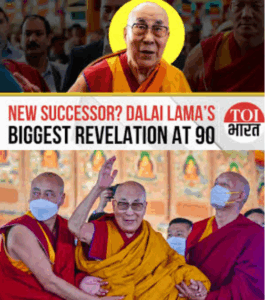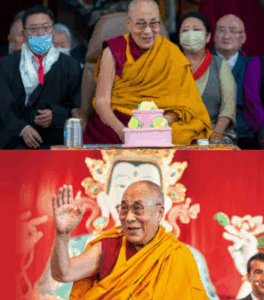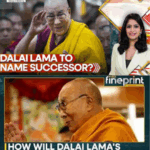Dalai Lama at 90: Is He About to Name Successor and Defy China?
DHARAMSHALA, India—As golden prayer flags flutter against the Himalayan sky, the world holds its breath. On July 6, the 14th Dalai Lama turns 90—a milestone shadowed by an unprecedented question: Will he defy centuries of tradition and China’s Communist Party by naming his reincarnation while still alive? Inside the Tsuglagkhang Temple, where monks chant sutras beneath towering Buddha statues, exiled Tibetans whisper about prophecies, political warfare, and a spiritual leader’s radical gamble to preserve his people’s faith. “The storm is coming,” says Tenzin Choedon, fingering her mala beads outside the temple. “But we’ve survived centuries. We’ll survive this.”
The Unthinkable Announcement: Breaking Taboos Before Beijing
Reincarnation in Tibetan Buddhism follows sacred rhythms: only after a lama’s passing do monks search for his rebirth. Yet this week, days before his birthday, the Dalai Lama convened over 100 Buddhist leaders—his first major gathering since 2019—and hinted at shattering protocol. “There will be some kind of framework,” he told devotees on July 1, “within which we can talk about the continuation of the institution of the Dalai Lamas.” The remark, delivered with characteristic calm, ignited global speculation. Sources close to the exile government reveal draft plans for a “living will” mechanism—a theological innovation allowing the current Dalai Lama to guide the search for his successor through visions and divinations before death.
China’s response was immediate fury. “He is a political exile with no right to represent Tibet,” declared Foreign Ministry Spokesperson Lin Jian in March, invoking Qing Dynasty edicts from 1793 that granted emperors authority over lama selections. Beijing insists any 15th Dalai Lama must be born in China, approved by the Party, and molded into a puppet of the state—a prospect Tibetans call “spiritual genocide.”

Exile’s Agony: “We Live Between Auspiciousness and Grief”
In McLeod Ganj’s bustling markets, where momos steam beside stalls selling “Free Tibet” T-shirts, birthday preparations mask profound anxiety. “Grateful to celebrate His Holiness,” murmurs Dorjee Tashi, hanging paper lanterns, “but every prayer carries fear.” This duality defines Dharamshala’s exile community: joy for their leader’s longevity, terror of losing their last living symbol of resistance.
The Dalai Lama himself fuels this tension. Though physically frail—using a wheelchair since 2021—his spirit blazes undimmed. At Monday’s gathering, he vowed: “The rest of my life I will dedicate for the benefit of others.” Yet his strategic hints about succession reveal deeper calculations. By suggesting his rebirth may appear in India—”a land of religious freedom”—he not only challenges China but reshapes Tibetan Buddhism’s geography. Historically, Dalai Lamas emerged near sacred lakes in Tibet; now, the faith’s heart may beat in exile forever.
China’s Spiritual Colonialism: From Qing Decrees to Modern Repression
Beijing’s claim over reincarnation rests on thin historical ice. The 1793 “Golden Urn” decree—requiring Tibetan lamas to draw names from a Qing emperor’s vessel—was imposed after imperial invasions, not spiritual consensus. Today, China weaponizes this legacy to erase Tibetan autonomy. In 1995, after the Dalai Lama recognized six-year-old Gedhun Choekyi Nyima as the Panchen Lama (Tibet’s second-highest figure), Chinese agents abducted the boy. He remains disappeared—replaced by a state-approved puppet.
This brutality extends beyond individuals. Since 2007, China’s Religious Affairs Administration has forced Tibetan monasteries to display portraits of President Xi Jinping beside Buddha statues. Over 6,000 monasteries now host Communist Party “patriotic education” offices—a system one defector called “faith reform through fear.”

The Exile Blueprint: Democracy as Dharma’s Shield
Anticipating China’s interference, the Dalai Lama spent decades building institutional armor. In 2011, he shattered a 368-year tradition by relinquishing political power to an elected parliament—the Central Tibetan Administration. “Spiritual and temporal roles must separate,” he declared, shielding reincarnation from state capture.
Now, two exile structures stand ready:
The Political Continuity Plan
- : Should the Dalai Lama pass, elected leaders will govern Tibetans globally while monks search for his rebirth.
The Reincarnation Foundation
- : Established in 2015, this body—led by senior lamas—will oversee search protocols using ancient methods: analyzing dreams, interpreting oracles, and scrutinizing signs in sacred landscapes.
“The Chinese want us to panic,” says Lobsang Sangay, former exile Prime Minister. “But we have a roadmap. Our faith isn’t fragile.”

The Global Chessboard: Why This Birthday Changes Everything
Five converging forces make this moment explosive:
The China-India Rivalry: With India hosting the Dalai Lama since 1959, any successor born on Indian soil would humiliate Beijing—and inflame border tensions.
Generational Shifts: Young Tibetans, raised in exile, increasingly demand assertive action against China. “Passive resistance won’t free Tibet,” argues activist Tsering Dolma.
Geopolitical Alignments: Western nations face pressure to recognize a future Dalai Lama chosen by exiles—risking trade wars with China.
Technological Threats: Experts warn China could deploy AI to fabricate “reincarnation evidence” or deepfake the Dalai Lama endorsing a puppet.
Environmental Prophecies: Some monks cite visions linking the 15th Dalai Lama’s birth to climate-ravaged Himalayan regions—a narrative challenging China’s development claims in Tibet.
The Unbroken Chain: Faith Beyond Politics
As birthday prayers rise on July 6, Tibetans draw strength from their leader’s own words: “Wherever I am born, I will serve.” For them, the succession crisis transcends politics—it tests whether compassion can outlast coercion.
In a Dharamshala courtyard, elderly monk Geshe Lhakdor contemplates sand mandalas destined for ritual destruction. “Impermanence is Buddha’s teaching,” he smiles. “But the Dalai Lama’s essence? That’s like space—uncontainable by borders or bullets.” Outside, pilgrims prostrate toward Tibet, their chants weaving through pine forests: “Om mani padme hum.” In these syllables, carried on mountain winds, lies exile’s quiet defiance—a vow that no matter who China anoints, Tibet will recognize its true lama in the unwavering light of a free heart.
Play video :
News
Dalai Lama’s Reincarnation: Interview With Penpa Tsering, President of Tibetan Govt in Exile
Dalai Lama’s Reincarnation: Interview With Penpa Tsering, President of Tibetan Govt in Exile DHARAMSHALA, India—In a monastery courtyard thick with…
Bergüzar Korel ailesinden ilk açıklama geldi: “Ören, bu çok zor bir süreç.”
Bergüzar Korel ailesinden ilk açıklama geldi: “Ören, bu çok zor bir süreç.” . . . Bergüzar Korel’den Üzücü Haber: Ailesinden…
143 families affected, many aggrieved: The pharma blast in Telangana
143 families affected, many aggrieved: The pharma blast in Telangana The acrid smell of chemicals still hung heavy over Sigachi…
Rakhi Sawant Crying badly as She took Anti Aging Pills dastroy her Face Like Shefali Jariwala!
Rakhi Sawant Crying badly as She took Anti Aging Pills dastroy her Face Like Shefali Jariwala! The digital landscape erupted…
Esha Deol fulfilled the last wish of 90-year-old Dharmendra by making the biggest sacrifice
Esha Deol fulfilled the last wish of 90-year-old Dharmendra by making the biggest sacrifice The golden sands of Mumbai’s film…
Akshay Kumar Gets Emotional At Shefali Jariwala Prayer Meet
Akshay Kumar Gets Emotional At Shefali Jariwala Prayer Meet The vibrant lights of Mumbai dimmed on the night of June…
End of content
No more pages to load












